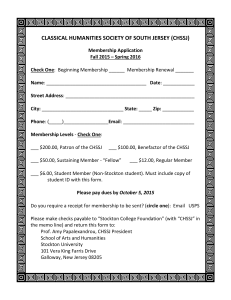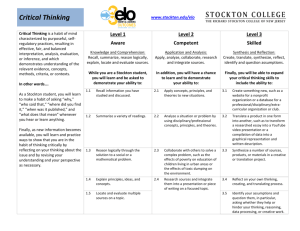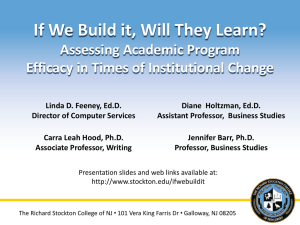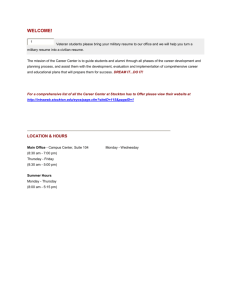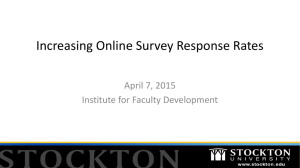Research Methods MAAS_SP14 - Richard Stockton College of New
advertisement
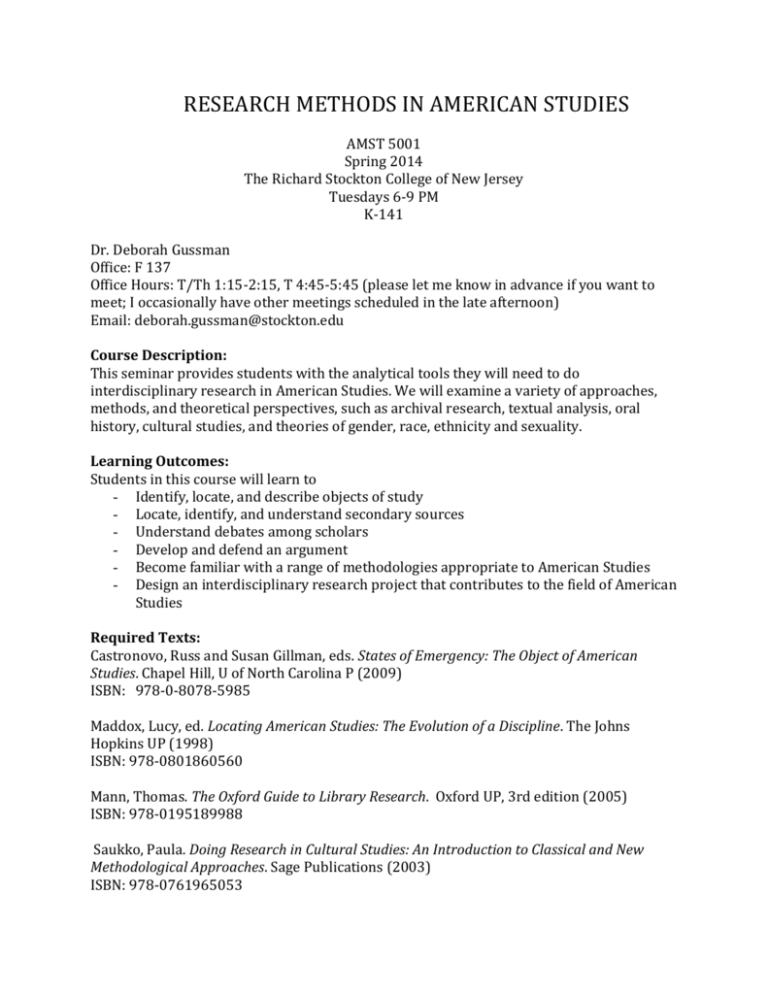
RESEARCH METHODS IN AMERICAN STUDIES AMST 5001 Spring 2014 The Richard Stockton College of New Jersey Tuesdays 6-9 PM K-141 Dr. Deborah Gussman Office: F 137 Office Hours: T/Th 1:15-2:15, T 4:45-5:45 (please let me know in advance if you want to meet; I occasionally have other meetings scheduled in the late afternoon) Email: deborah.gussman@stockton.edu Course Description: This seminar provides students with the analytical tools they will need to do interdisciplinary research in American Studies. We will examine a variety of approaches, methods, and theoretical perspectives, such as archival research, textual analysis, oral history, cultural studies, and theories of gender, race, ethnicity and sexuality. Learning Outcomes: Students in this course will learn to - Identify, locate, and describe objects of study - Locate, identify, and understand secondary sources - Understand debates among scholars - Develop and defend an argument - Become familiar with a range of methodologies appropriate to American Studies - Design an interdisciplinary research project that contributes to the field of American Studies Required Texts: Castronovo, Russ and Susan Gillman, eds. States of Emergency: The Object of American Studies. Chapel Hill, U of North Carolina P (2009) ISBN: 978-0-8078-5985 Maddox, Lucy, ed. Locating American Studies: The Evolution of a Discipline. The Johns Hopkins UP (1998) ISBN: 978-0801860560 Mann, Thomas. The Oxford Guide to Library Research. Oxford UP, 3rd edition (2005) ISBN: 978-0195189988 Saukko, Paula. Doing Research in Cultural Studies: An Introduction to Classical and New Methodological Approaches. Sage Publications (2003) ISBN: 978-0761965053 2 Assignments: Weekly reading responses (aka “How do I know what I think until I see what I say?”), posted to Blackboard by noon Monday before class (20%) Instructions for the weekly reading responses students: What should the weekly responses do? At minimum, the responses should accomplish #1 and #2. Aim to also tackle #3, or #4 (your choice). 1) Make sense of the readings: What is the main argument? What methods or kinds of evidence is the writer using to develop and support the argument? 2) Relate the theory/scholarship to objects of study: How does the reading help us to understand a particular object of study (a text, performance, idea, event, etc.)? If it isn’t useful, explain why. 3) Make connections between the readings: Do the readings address similar questions or topics? Do they come to different or similar conclusions? 4) Make broader connections: Relate the week’s readings to broader issues in the course or in American Studies. Citation/American Studies journals assignment (5 pages, posted to Blackboard by 10/12): 20% JSTOR lists 125 titles under “American Studies.” You will be assigned 10 American studies journals to review. Then you will answer the following questions about each journal examined: What is the journal’s mission or focus? What kinds of articles do they publish? What are some of the sources/objects of study represented in the journal? What methods and disciplinary approaches are used? Who is the sponsoring organization? What is the citation style (ie. MLA, Chicago, APA) and why might they use that form? Who reads/publishes in the journal? Does the citation style fit the mandate of the journal? Your paper should include some substantive reflection on the information you collected in the form of an introduction and/or conclusion. The reflection should address your overall impressions or observations about the field garnered from looking closely at a wide range of scholarship, generated over a long period of time. Secondary Source analysis (3-4 pages, posted to Bb by 4/10) (10%) – instructions posted on Bb Final project: Thought experiment/Research Portfolio (with annotated bibliography) 40% Each of you will be conceptualizing and designing an American Studies project, using Castronovo and Gillman’s questions as a starting point: 3 “Imagine that you have an object and that you want to study it. The object could be anything, an artifact drawn from popular culture, a text culled from the archive, even something that is more of a moving target because of its location across and between cultures. In the pluralist ethos that characterizes the field, your object could be lowbrow or highbrow, material or virtual, national or transnational . . . Now that you have your object, which methodologies will contextualize and explain your selection? . . . what goal do you have in studying, recovering, or critiquing your object?” (Castronovo and Gillman, States of Emergency, 3-4) While you will not actually complete the project, you will be using the readings and activities of the course to compare and contrast possible research methods, to consider the kinds of questions particular approaches might encourage, the kinds of opportunities different approaches might allow. As you consider these issues, you will be developing a set of resources that could be used to bring such a project to fruition, including (but not limited to) an annotated list of journals and databases related to the topic; a description of primary sources, archives or collections related to the topic; a discussion of the scholarly conversation and bibliography of the major works of scholarship that already exist in relation to the topic; and a reflection on how this topic might contribute to the field of American Studies. You will provide two progress reports, as well as a final paper and presentation. Details on the progress reports and paper will be posted on Blackboard, and can be found at the end of the syllabus. Facilitators/Note takers: each student will facilitate the discussion of one reading that he or she has selected (guidelines for selection will be posted on Bb), and be responsible for taking and posting class notes on Blackboard for one class session. 10% Special Needs: Students with disabilities who seek accommodations should contact the Learning Access Program located in J-204 (609-652- 4988). More information can be found at <http://www2.stockton.edu/wellness/lap.html> Academic Honesty: The MAAS program expects students to maintain the highest standard of academic honesty. You should make yourself aware of Richard Stockton College’s Academic Honesty Policy, which can be found in the Student Handbook. <http://intraweb.stockton.edu/eyos/page.cfm?siteID=14&pageID=62> You should also make yourself familiar with the penalties for violations of the policy and your rights as a student. Please be aware that plagiarism (one form of academic dishonesty) includes, but may not be limited to: using all or part of a source, either directly or in paraphrase, either intentionally or unintentionally, whether that source is published, or online, or taken from a fellow or former student, without properly acknowledging that source. 4 If you are found to have represented the work or ideas of others as your own, intentionally, or unintentionally, you will face serious consequences, as follows: 1. If this is the first time the student has been found to have plagiarized, he/she will receive an "F" for that paper or assignment and/or the course. 2. For second offenses of plagiarism, the student will receive an F for the course. 3. Whenever possible, a student who is found to have plagiarized a paper or assignment, in full or in part, should meet with the professor of the class for which the paper is written in order to review and discuss the suspect work. Additionally, in accordance with Stockton College policy, faculty will report all instances of plagiarism to the Provost of Academic Affairs. Students may be subject to discipline by the college, such as being placed on academic probation or expelled. If you have a question specific to a paper you are working on, please bring it to my attention. Course Schedule (subject to change – be sure to check Blackboard regularly for updates and announcements). September Week 1 T 1/21 Getting started: introductions and overviews. Notetaker assignments. Read: “Preface,” Oxford Companion to Library Research, xiii-xix "American Studies: An Overview." Encyclopedia of American Studies. : Johns Hopkins University Press, 2010. Credo Reference. Web. 09 August 2012 and "American Studies: Approaches and Concepts." Encyclopedia of American Studies. : Johns Hopkins University Press, 2010. Credo Reference. Web. 09 August 2012. "Culture and Cultural Studies." Encyclopedia of American Studies. : Johns Hopkins University Press, 2010. Credo Reference. Web. 09 August 2012. Direct link to encyclopedia: http://www.credoreference.com/book/jhueas (must login using goStockton portal info) Week 2 T 1/28 Read: Castronovo and Gillman, “The Study of American Problems” 1-16 (SoE) Saukko, Part 1, Thinking Methodologically, 11-35. Browse: Chs. 4-10 of the Oxford Guide. Discuss citation assignment. Due: Reading response essay Week 3 T 2/4 Defining Culture 5 Raymond Williams, “Culture” http://pubpages.unh.edu/~dml3/880williams.htm “The Cultural Turn and American Studies” http://www.youtube.com/watch?v=p2RFGE_pSsU Melching, Jay. “Some [New] Elementary Axioms for an American Cultur[al] Studies” American Studies 38. 2 (1997) 9-30 (Bb) Due: Reading response essay Week 4 T 2/11 Archives and Objects Read: Rodrigo Lazo, “Migrant Archives: New Routes in and Out of American Studies” (SoE 36-54) Sherratt, Tim. “It’s All About the Stuff: Collections, Interfaces, Power, and People.” Journal of Digital Humanities 1.1 (2011) http://journalofdigitalhumanities.org/1-1/its-all-about-the-stuff-by-tim-sherratt/ Todd, Emily B. “Antebellum Libraries in Richmond and New Orleans and the Search for the Practices and Preferences of ‘Real’ Readers.” American Studies 42.3 (2001): 195–209. (Bb) Motz, Marilyn F. “Visual Autobiography: Photograph Albums of Turn-of-the-Century Midwestern Women.” American Quarterly 41.1 (1989): 63–92. (Bb) Document Analysis Worksheets, LOC: http://www.archives.gov/education/lessons/worksheets/ Recommended reading: Jimerson, Randall C. “Archives for All: Professional Responsibility and Social Justice.” The American Archivist 70.2 (2007): 252–281. (Bb) Carter, Rodney G.S . “ Of Things Said and Unsaid: Power, Archival Silences, and Power in Silence.” Archivaria 61 (Spring 2006) 215-233 (Bb) Discuss the final project. Troubleshooting Citation assignment. Due: Reading response essay Week 5 T 2/18 Mass and Popular Culture Saukko, Part II Studying Lived Experience 39- 73 “The Origins of Mass Culture” Richard Ohmann (Radway) Bb Radway, Janice, “The Utopian Impulse in Popular Literature: Gothic Romances and “Feminist” Protest” (LAS) Meloy, Mike, “From Kid Nation to Caste Nation: Mobility, Privilege, and the Paradox of Class on Reality Television.” Americana: The Journal of American Popular Culture 8:1 (2009). http://www.americanpopularculture.com/journal/articles/spring_2009/meloy.htm Citation assignment due on Blackboard by midnight TH 2/20 Due: Reading Response Essay Week 6 6 T 2/25 Ethnography Read: Saukko, Part II Studying Lived Experience (74 – 95) Nan Enstad, “Toxicity and the Consuming Subject” (SoE 55-68) Anne McClintock, “Paranoid Empire: Specters from Guantanamo and Abu Ghraib” (SoE 88115) Due: Reading Response Essay Week 7 T 3/4 Textual analysis Read: Saukko, Part III “Reading Discourses” (97-114, 135-152) Houston A. Baker, Jr., “Figurations for a New American Literary History” in Ideology and Classic American Literature, ed. Bercovitch and Jehlen http://xroads.virginia.edu/~DRBR/baker.html Due: Reading Response Essay First Progress report for thought experiment due on Blackboard by Thursday 3/6 11:59 pm MARCH 8 – 16 SPRING BREAK: CLASS DOES NOT MEET Week 8 T 3/18 Local and Global Contexts Read: Saukko, Part IV “Analysis of Reality and Space” 155-175; “Studying Multiple Sites and Scapes” 176- 197 Kevin J. Mumford, “Homosex Changes: Race, Cultural Geography, and the Emergence of the Gay” (LAS) Kenneth Warren, “Taking the Measure of the Black Atlantic” (SoE, 116-123) Due: Reading Response Essay Week 9 T 3/25 Student selected reading and analysis Due: Reading Response Essay Second Progress report for thought experiment due on Blackboard by Thursday 3/27 11:59 pm W 3/26 Paul Lyons Memorial Lecture featuring Lonnie Bunch, Director of the Smithsonian’s National Museum of African American History and Culture. 6-7:30 in the Campus Center Theater. More information about Mr. Bunch can be found here: http://www.washingtonpost.com/lifestyle/style/lonnie-bunchs-vision-for-the-museumof-african-american-history-and-culture/2012/02/06/gIQAffc8JR_story.html http://newsdesk.si.edu/about/bios/lonnie-g-bunch Week 10 7 T 4/1 Student selected reading and analysis Due: Reading Response Essay Week 11 T 4/8 Student selected reading and analysis Due: Reading Response Essay Secondary Source analysis due on Bb on Th 4/10 by 11:59 pm Week 12 4/15 Student selected reading and analysis Due: Reading Response Essay Week 13 4/22 Thought experiment round table/presentations Week 14 4/29 Thought experiment round table/presentations Final project due Friday 5/2 by 11:59 pm. Online course resources (in progress): 49th Parallel: An Interdisciplinary Journal of North American Studies: http://www.49thparallel.bham.ac.uk/index.htm American Studier: a central online resource for students of American culture http://www.americanstudier.org/blog/ American Studies Association: http://www.theasa.net/ American Studies at UVA: http://xroads.virginia.edu/ American Studies Resources and Links (Cal State Fullerton): http://hss.fullerton.edu/amst/resources.asp 8 Black Thought and Culture (Stockton library database) Bjork Library Web Site Map: http://intraweb.stockton.edu/eyos/page.cfm?siteID=86&pageID=90 Center for Working Class Studies: http://cwcs.ysu.edu/resources Companion Website to American Cultural Studies: An Introduction (includes links to a wide range of non-subscription based online archives and databases) http://www.routledge.com/cw/campbell-9780415598712/ CRGE (Consortium on Race, Gender, & Ethnicity) Intersectional Research Database: http://mith.umd.edu/crge/ird/ Guide to American Studies Resources (Bjork Library, Stockton College): http://libguides.stockton.edu/content.php?pid=332920 Guide to Literature Resources (Bjork Library, Stockton College): http://libguides.stockton.edu/cat.php?cid=24870 Index of Articles in American Studies Theory and Method: http://xroads.virginia.edu/~DRBR/rbrindx1.html Keywords for American Cultural Studies Collaboratory: http://keywords.fordhamitac.org/wiki2/index.php?title=Welcome_to_the_Keywords_Colla boratory New Jersey Digital Highway: http://www.njdigitalhighway.org/ New Jersey Historical Society: http://www.jerseyhistory.org/index.htm New Jersey State Library: http://slic.njstatelib.org/ New Jersey State Archives: http://www.njarchives.org/ New Jersey State Museum: http://www.state.nj.us/state/museum/ North American Women’s Letters and Diaries (Stockton library database) The Poetess Archive: http://www.poetessarchive.com/ Professor Musher’s Guide to Doing History (Bjork Library, Stockton College) http://libguides.stockton.edu/mush 9 Special Collections and University Archives, Rutgers: http://www.libraries.rutgers.edu/rul/libs/scua/scua.shtml Transatlantic Slave Trade Database: http://www.slavevoyages.org/tast/index.faces Theory and Method in American Cultural Studies (T.V. Reed): http://public.wsu.edu/~amerstu/tm/diff.html Bibliography and Citation sources: The Bedford Bibliographer (very accurate citation generator): http://bcs.bedfordstmartins.com/rewriting/rcBB.html Zotero (a free Firefox extension for collecting, managing, citing, and sharing research sources.): http://www.zotero.org/ Thought Experiment: Detailed Instructions Thought Experiment Progress Report 1: 3-4 pages, plus a preliminary annotated bibliography (info on annotated bibliography is posted on Bb). By now you need to have selected the object you intend to study this semester. Write an account of what draws you to this object of study, what about it attracts you. Then, answer the following questions, in as much detail as you can at this point: 1) What do you already know about this object and the popular and/or scholarly conversation that surrounds it? (For some of you the answer to this question may be substantive, for others, more exploratory). 2) What questions do you have about the object of study? What do you want to know, explain, analyze? This is where you get to pose some research questions and tentative hypotheses. (A hypothesis is a tentative and provisional statement of what you believe you are going to find out as a result of your research. It can be seen as a potential answer to a research question. The aim of the research is to support or verify the hypotheses or show that they are not valid statements. It is not essential to have hypotheses when embarking on research, but it is helpful to understand what they are.) 3) Where will you look for more information? This will require some preliminary research to see what kinds of books, articles, websites, archives, databases, etc. are available to you. The Oxford Guide To Library Research has an excellent listing of reference works that are useful for general information (1-17), an overview of databases (72-89), a discussion of the 10 value of literature review articles and published bibliographies (134-140, 141-152), and people sources (185-203) and “Hidden Treasures” (eg. microform sets, web collections, government docs, archives and public records, and special collections, 204-237.) 4) What form do you see a final project on this object of study taking? (ie. a traditional research paper or thesis, a digital work such as a hypertext or website, a curriculum proposal, a museum exhibit, etc.) Thought Experiment Progress Report 2 The focus of your second progress report will be to develop issues or answer questions I posed in your first report AND to consider which methods and techniques would be most (and perhaps least) useful for understanding or making an argument about your object of study (eg. dialogic validity, deconstructive validity, contextual validity, textual analysis, ideological analysis, genealogical analysis, deconstructive/poststructuralist analysis, ethnography, comparative analysis, oral history, spatial analysis.) It will be useful to return to Saukko for explanations of some of these terms, as well as to consider any of the readings we've done for class (or that you've done in your preliminary research or Proseminar) as models for your project. Be sure to explain both how you would use a particular method and why it would be a good choice for your project, and to cite sources (including Saukko) for any explanations or examples. Thought Experiment Final Paper and Presentation For the final paper, you will synthesize the research and thinking you have done in the two progress reports and your readings in American Studies topics and methods. To that end, you will write a 7-8 page proposal for a possible independent study or capstone project that you might undertake as part of your degree program. (While I realize that some of you may not pursue these projects, the process of writing a proposal should still be valuable practice for the projects you do choose to complete.) The proposal will bring together the work you have already completed, and whatever additional research and thinking is needed to sufficiently develop or clarify your ideas. The purpose of writing a proposal is to demonstrate that the independent study, thesis, or capstone project addresses a significant issue in your field; that you have an original or important argument about it; and that you have an organized plan to develop and support that argument. So the first step is to write a proposal of approximately four -five pages, comprised of the points described below, which lays out the issues and the tentative argument you plan to make about your topic. [For the purposes of this assignment, the table of contents is optional. The table of contents at this stage of the game would be very preliminary, but might give an idea of how you would like to structure the project by dividing it into chapters or sections. A thesis on toxicity, for instance, might devoted 15page chapters each to the definition of toxicity, the spread of toxicity, its relation to global capitalism and nationalism, and examination of a case study.] 11 1. A succinct working title that summarizes the project (i.e. indicates your topic) 2. A summary of the project’s main issue, which should include one (or more) of the following: a. hypothesis; b. research question; or c. a project statement 3. A detailed discussion of your methodology. This section should specify three points: a. research methods to collect data; b. research methods to analyze data; and c. the types of materials that will be used (e.g. books, interviews, archives). Please be sure to use and cite Saukko in this section, and any other sources or models you might use. You need to explain why the method(s) you have chosen are best suited to the development of your project. 4. A discussion of the anticipated conceptual significance (i.e. relevance to American Studies): What new knowledge or argument will the proposed project produce that we do not already know? How does it impact American studies scholarship? You will need to discuss and cite secondary sources in this section. 5. [OPTIONAL] A table of contents, comprised of: a. The titles of each chapters; b. Two to three sentences describing the tentative focus of the chapter. 6. An annotated bibliography listing resources that you might draw upon. This bibliography should have about 20 articles, books, and websites, and is not included in the final page count. Outlining these points in a proposal makes it far easier to complete. A secondary purpose of the proposal is training in the art of proposal writing – a skill required in just about any humanities or social-science related career, from industry to academia. Remember, project and proposal plans may change, and many excellent theses bear little resemblance to the original proposal. So the purpose of the proposal is not to form a sure-fire project with no risk of failure. Rather, the purpose is to demonstrate that you understand the process and structure of research. If you can present a clear and reasonable idea, relate it to other relevant literature, justify its significance, and describe the steps for investigating it, then the proposal is likely to be successful regardless of whether you modify or even scrap the initial idea. For the presentation you will prepare a Powerpoint or Prezi show consisting of 5-8 slides (basically covering each of the numbered items listed above). You may include relevant images as well as text. Please DO NOT read off of your slides. Your slides should include only key points, quotes, or images. Use note cards, or the notes area of the presentation to delineate your ideas.
